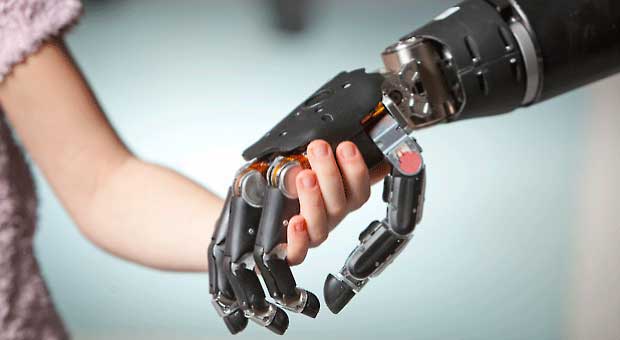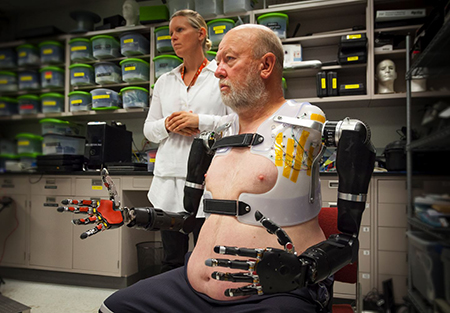A Step Forward: APL’s Modular Prosthetic Limb

Les Baugh, a bilateral shoulder-level amputee from Colorado, US, entered history as the first man who simultaneously controlled two Modular Prosthetic Limbs (MPL) only with the help of his thoughts. Today, 40 years after the electrical accident that took both his arms, Baugh regained control over his limbs and successfully performed a series of tasks after a relatively short period of training. The Modular Prosthetic Limbs that Baugh used were developed by Johns Hopkins University Applied Physics Laboratory (APL) as part of the Revolutionizing Prosthetics Program.
Before training, Baugh had to undergo a targeted muscle reinnervation, a surgical procedure pioneered by Todd Kuiken, MD, PhD, director of the Neural Engineering Center for Artificial Limbs (NECAL) at the Rehabilitation Institute of Chicago (RIC) in Illinois. This surgery enables patients to regain sensory feedback and control sophisticated, motorized prosthetic limbs and it’s especially beneficial for above-elbow amputees. The aim of the surgery is transferring nerves into separate regions of the muscle, recording and using the EMG signals to control a prosthetic device.
 APL prosthetist Courtney Moran looks on as Les Baugh tests out the Modular Prosthetic Limbs
APL prosthetist Courtney Moran looks on as Les Baugh tests out the Modular Prosthetic Limbs
Dr. Albert Chi, Johns Hopkins Trauma Surgeon, gave a detailed explanation of the procedure in the news release: “It’s a relatively new surgical procedure that reassigns nerves that once controlled the arm and the hand. By reassigning existing nerves, we can make it possible for people who have had upper-arm amputations to control their prosthetic devices by merely thinking about the action they want to perform. We use pattern recognition algorithms to identify individual muscles that are contracting, how well they communicate with each other, and their amplitude and frequency. We take that information and translate that into actual movements within a prosthetic.
Ivanovic J (2015-01-09 13:27:59). A Step Forward: APL’s Modular Prosthetic Limb. Australian Science. Retrieved: Apr 24, 2024, from http://australianscience.com.au/research-grants-and-programs/medical-and-health-sciences-research-grants-and-programs/step-forward-apls-modular-prosthetic-limb/
 Follow
Follow